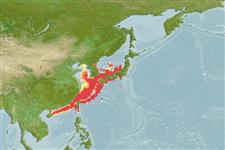sub class Elasmobranchii (ฉลามและกระเบน) (sharks and rays) >
Squatiniformes (Angel sharks) >
Squatinidae (Angel sharks)
Etymology: Squatina: Latin for skate, which angel sharks superficially resemble, presumably tautonymous with Squalus squatina Linnaeus 1758 (no species mentioned). (See ETYFish); japonica: -ica (L.), belonging to: Japan, referring to Nagasaki, type locality. (See ETYFish).
More on author: Bleeker.
Environment: milieu / climate zone / depth range / distribution range
นิเวศวิทยา
เกี่ยวกับทะเล,น้ำเค็ม สัตว์น้ำหน้าดิน. Subtropical; 41°N - 19°N, 111°E - 139°E (Ref. 54906)
Northwest Pacific: Japan, Yellow Sea, Korea, and northern China.
ขนาด / น้ำหนัก / Age
Maturity: Lm ? range ? - ? cm
Max length : 200 cm TL เพศผู้/กระเทย; (Ref. 247)
เงี่ยงครีบหลัง (รวม): 0; ก้านครีบอ่อนที่หาง (รวม): 0; เงี่ยงครีบก้น 0; ก้านครีบอ่อนที่ก้น: 0. Japanese angelshark Squatina japonica has broad pectoral fins with rounded free rear tips, posterior margin nearly straight, inner margin strongly convex; nasal barbels simple and spatulate. Anterior nasal flaps smooth to weakly fringed; dermal folds on sides of head without lobes. Rear tip of inner margin of pelvic fins considerably anterior to origin of first dorsal; very short hypocercal tail. Rows of moderately large spines on midline of back and tail from head to dorsal fins and between fin bases, and on snout and above eyes. Body color blackish brown with small dark and pale spots; no ocelli (eye-like spot) (Ref. 247, 31369, 12951).
A little-known angelshark, found on or near the bottom (Ref. 247). Lives in sandy ground. A carnivore that eats benthic animals (Ref. 9137). Ovoviviparous (Ref. 50449). Utilized for human consumption and for preparation of shagreen (Ref. 247).
Life cycle and mating behavior
วัยเจริญพันธุ์ | การสืบพันธุ์ | การวางไข่ | เซลสืบพันธ์ของเพศเมีย(ไข่) | ความดกของไข่ | ตัวอ่อน
Ovoviviparous, embryos feed solely on yolk (Ref. 50449).
Compagno, L.J.V., 1984. FAO Species Catalogue. Vol. 4. Sharks of the world. An annotated and illustrated catalogue of shark species known to date. Part 1 - Hexanchiformes to Lamniformes. FAO Fish. Synop. 125(4/1):1-249. Rome, FAO. (Ref. 247)
IUCN Red List Status (Ref. 130435)
Threat to humans
Traumatogenic
Human uses
การประมง: มีการค้าเพียงเล็กน้อย
ข้อมูลเพิ่มเติม
ชื่อสามัญชื่อพ้องกลไกการเผาผลาญพลังงานผู้ล่าการศึกษาเกี่ยวกับผลกระทบของสารประกอบทางเคมีที่เป็นอันตรายต่อสิ่งมีชีวิต ประชากร และสิ่งแวดล้อมการสืบพันธุ์วัยเจริญพันธุ์การวางไข่การรวมกลุ่มวางไข่ความดกของไข่เซลสืบพันธ์ของเพศเมีย(ไข่)Egg development
อ้างอิงการเพาะเลี้ยงสัตว์น้ำประวัติการเพาะเลี้ยงสัตว์น้ำสายพันธุ์พันธุศาสตร์ElectrophoresesอัตราพันธุกรรมโรคการแปรรูปNutrientsMass conversion
ผู้ร่วมมือรูปภาพหลายรูปStamps, Coins Misc.เสียงปลามีพิษ เช่น ปลาปักเป้าความเร็วรูปแบบการว่ายน้ำพื้นที่เหงือกOtolithsสมองวิสัยทัศน์
เครื่องมือ
Special reports
Download XML
แหล่งที่มาจากอินเตอร์เน็ต
Estimates based on models
Preferred temperature (Ref.
123201): 5.7 - 20.7, mean 17.3 °C (based on 123 cells).
Phylogenetic diversity index (Ref.
82804): PD
50 = 0.5000 [Uniqueness, from 0.5 = low to 2.0 = high].
Bayesian length-weight: a=0.00676 (0.00293 - 0.01558), b=3.07 (2.88 - 3.26), in cm total length, based on LWR estimates for this Genus-body shape (Ref.
93245).
ระดับชั้นอาหาร (Ref.
69278): 3.5 ±0.37 se; based on food items.
ความสามารถในการกลับคืนสู่ปกติ (Ref.
120179): ต่ำ, เวลาต่ำสุดที่จะทำให้ประชากรเพิ่มขึ้นเป็น 2 เท่าใช้เวลา 4.5 - 14 ปี (Fec assumed to be <100).
Fishing Vulnerability (Ref.
59153): Very high vulnerability (90 of 100).
